Ladakh is a long list of tourist attractions. Some are very well-known, and some are still unexplored. Some are easily accessible while others will require you to make some effort to reach. But they are all equally stunning and unique. One such amazingly beautiful sight is the Sangam Point in Ladakh.
It is the meeting point of the Indus and Zanskar rivers and is also known as the confluence of the Indus and Zanskar rivers. Other than being a beautiful sight, it is also the place where adventure activities like rafting, chadar trek, and bungee jumping in Ladakh take place.
I recently was on a road trip to Ladakh and on the 37th day of our trip, we visited the Sangam Point near Leh. The post below is a brief narration of our visit and also provides several necessary details on planning a trip. To read the previous parts of the travelogue, please follow the links below.
Journey So Far:
- Murgi Waterfall & Ensa Gompa – Day 33
- Nubra Valley to Pangong Lake via Shyok Road – Day 34
- Pangong Lake to Leh via Changla Pass – Day 35
- Leh Hall of Fame – Day 36
- Zorawar Fort – Day 36
- Gurudwara Pathar Sahib – Day 37
This vantage point in recent years has become one of the most visited tourist spots in Ladakh. It is at a short distance from Leh City, easily accessible, and is perfect for visiting with families. If you were traveling from Srinagar to Leh or vice versa, you could actually cover the confluence point on the way. You can also take a look at the video below from our visit.
Sangam Point Ladakh
Let us first take a look at a little bit of history. The word ‘Sangam’ was a recent addition and came into use only after the increase in tourism in Ladakh in the last few years. Go back a decade or 15 years and it was just called the confluence point or just the meeting point.
Slowly, as more and more people started to visit Ladakh in recent years, the word Sangam was introduced, and that is how the place got named as such. The word literally means a confluence of rivers and aptly describes the place.
And it is not just the confluence point that got renamed. The surrounding area as well is now known as Sangam Valley. Even the local taxi drivers have started to refer to this name only as it is easier for tourists to recognize.
Indus River
The Indus River, also known as ‘Sindhu’ really needs no introduction. It is one of the longest rivers in Asia and has a special place in Human History. It was the birthplace of the great Indus Valley Civilization in the 3rd millennium BC and a lifeline to the ancient cities of Harappa and Mohenjo-Daro.
Even the name of our country “India” is said to have been derived from the Indus River. The river originates or forms at the confluence of the Sengge Zangbo and Gar Tsangpo rivers in Tibet. It then flows into Ladakh in India where first the Shyok River and then the Zanskar River merge into it.
The river then flows into Pakistan. Throughout its length, it is joined by numerous other rivers like the Panjnad and Kabul rivers before it finally merges into the Arabian Sea.
Zanskar River
Zanskar River is formed in Zanskar Valley as a result of two rivers. The first one is the Doda River which originates from the Drang-Drung Glacier near Pensi La Pass. It then runs a total length of about 79 kilometers towards Padum, before it is joined by the Lungnak River.
The Lungnak River is formed near the village of Purne as a result of the confluence of Kargyag and Tsarap rivers. This river flows into Zanskar’s central valley where it joins the Doda River to form the main Zanskar River. Zanskar River then turns northeast, flows through the Zanskar Gorge, and then unites with the Indus near Nimmu Village at the spot that is now known as Sangam Point.
Confluence of Indus and Zanskar Rivers
What really makes the Confluence of Indus and Zanskar a truly wonderful sight is the color of the water as well as the flow. It changes all year long. The four pictures of the confluence I posted in this article were taken at different times and during different trips.
In the first picture, you will notice that the color of Indus is light green while Zanskar is crystal blue. In the second picture, you will see how the color of the Indus has become dark green whereas Zanskar has turned completely muddy.
The third picture was taken in January showing both the rivers frozen and completely white. In the fourth picture, water in both the rivers is almost of the same muddy color.
It is not just the color but also the flow of the water that changes. During the months from July to September, the flow of the water increases greatly, flooding the banks of the rivers. During the winter season, the flow diminishes. Zanskar River freezes in the months from December to February and its flow of water becomes even lesser than Indus.
Also Read: How to Plan a Trip to Leh Ladakh – A Complete Travel Guide
Where is Sangam Point in Ladakh
The confluence point of the Indus and Zanskar rivers is located about 35 kilometers from Leh, just before Nimmu Village on Srinagar Leh Highway.
A road bifurcates from the main highway and then brings you right to the river bank after a short drive of about 3 kilometers. This same road continues for about 25 kilometers along the banks of the Zanskar River before ending at Chilling Village.
Day 37 – Sangam Point – Indus Zanskar Confluence
It was the 37th day of our road trip to Ladakh when we visited the Sangam point. The overall plan was to go for a tour of Sham Valley, a destination in Ladakh that is still somewhat offbeat and doesn’t receive as many visitors.
Sham Valley is located a little ahead of the village of Likir, on the right side of Srinagar Leh road, at a distance of about 70 kilometers from Leh. It is a wide valley that consists of several small villages like Saspochey, Suspol, Bazgoo, Uley, and Hemis Shukpachan.
A tour of Sham Valley can be done in the form of a full circuit. From Leh, you will start driving towards Kargil on the Srinagar Leh highway. Tourist attractions like Magnetic Hill, Gurudwara Patthar Sahib, and the Indus Zanskar River confluence will all fall along the way. For more details, you can take a look at How to Plan a Trip to Sham Valley.
So our plan was that we will take breaks at Gurudwara Pathar Sahib, Magnetic Hill, and Sangam Point. From there, we will continue to Sham Valley and drive around in a complete circle, exiting once again on the Srinagar Leh road. On our way back, if time allowed, we could also cover the monasteries of Alchi and Likir.
Without a doubt, this was going to be a long tour covering a lot of places. In order for us to successfully complete the tour without rushing, we would need at least 12 to 13 hours. This needed an early start from Leh, as early as possible.
Leh to Gurudwara Pathar Sahib
So we woke up at around 6 am. After a light breakfast, by 7 am, we drove out of the hotel and started our Sham Valley tour. The first destination of the day was Gurudwara Pathar Sahib.
We reached the Gurudwara in 20 minutes and spent about an hour there. We offered prayers and then had some delicious Maggie in the early morning Langar followed by some tea. I have talked about this in the previous part of the travelogue. After that, we continued our journey. We drove for another 4 kilometers and reached our next destination – the Magnetic Hill of Ladakh.
Gurudwara Pathar Sahib to Magnetic Hill
So what is the magnetic hill in Leh Ladakh exactly? Magnetic Hill is a small stretch of road on the Srinagar Leh highway, about 50 meters in length. You do not have to climb a mountain or get on top of a hill to witness it. It is right there on the road itself.
While traveling from Leh to Kargil, after 30 kilometers, you will reach a point where the road will run downhill for about 3-4 kilometers straight. After that, for only a short distance of about 50 meters, the road becomes flat. Then it appears to be going uphill for another 50 meters and then goes downhill again.
The area where the road is flat is marked by yellow lines. If you park your car on these yellow lines and turn the ignition off, your car will still get in motion and cover that next 50 meters of the uphill road all on its own. After this, the road becomes downhill again and the car will continue to move and gain speed.
See the image below. This flat road is what is called the magnetic hill of Ladakh. It appears flat in the picture but actually has a very slight incline. The road runs straight like this for about 50 meters and then turns right, going downhill again.
So the entire mystery is around this approximately 100 meters length of the road – 50 meters flat and 50 meters uphill. The famous magnetic hill mystery is how a vehicle gets in momentum and climbs 50 meters of ascent without its engine running.
If you want to know what I am talking about, take a look at the video below. This was shot when I was testing the effects of Magnetic Hill in my Mahindra Thar.
What is the Ladakh Magnetic Hill Mystery?
As per the most common theory, a magnetic force so strong that it can pull cars uphill is believed to be behind this mysterious phenomenon. The large mountain right in front of the road is said to be the source of this magnetic force.
It is in fact so notorious that even the airplanes that fly over this region increase their altitude in order to avoid magnetic interference. Below is the description of the place on a board placed by the authorities.
Other than the Magnetic Hill theory, there are of course several other theories related to this place – some superstitious and others more rational. If you want to read about it in detail, please take a look at The Truth Behind Mysterious Magnetic Hill of Ladakh.
We spent another 30 minutes at Magnetic Hill, testing its effects and having fun. After that, we again continued our journey and moved on to the next destination on our list – Sangam Point.
Magnetic Hill to Sangam Point
Sangam Point is barely 7 kilometers from Magnetic Hill and it did not take us any longer than 10 minutes to cover the distance. We arrived at the spot and the first thing to do was to click some pictures from the highway.
After that, we turned left on the downhill road and reached the spot where the rivers merge. It was still early in the morning and there weren’t a lot of people around. We walked around, clicked some pictures, and shot some videos.
This is also the spot where the river rafting in Ladakh happens. About 10 kilometers from here on the road straight is where you can also enjoy Bungee jumping. In the winter season, the famous Chadar Trek also starts from this same spot. Below is the rafting rates list if you are interested in going rafting in Ladakh.
Even though it was early morning, the sun was already very harsh. Since there were no trees as well, it was hard to find shade anywhere and the burning sun was making it difficult to be there anymore. There wasn’t anything else to do as well actually so after about 15 minutes, we continued our journey to Sham Valley.
Before I move on with the travelogue, let me also provide a little more information on how you can plan your trip to Sangam Point from Leh either by your private vehicle or public transport.
How to reach Indus Zanskar River Sangam?
If you were traveling to or from Srinagar, then you can actually visit the confluence as you move along the highway. It is visible from the main highway itself and you can take a short break to click some pictures before continuing your journey. If you have some time, then you can take half an hour out to go down to the riverbank and spend some time there.
If you reached Leh by flight or going to Srinagar wasn’t part of your itinerary, then Sangam usually becomes a part of the Sham Valley tour. What you can also do is start early from Leh and drive on the Srinagar Leh highway until Lamayuru.
On the way, you will see the Indus Zanskar River Confluence, Magnetic Hill, and Gurudwara Patthar Sahib. Have lunch at Lamayuru and visit the monastery here. After a short break, you will then drive back to Leh. While returning, you can also visit the monasteries at Likir and Alchi.
Rent a Motorcycle
The best way to make the journey I described above would be by your own vehicle of course. If not, you can rent a motorcycle in Leh City and use it for local sightseeing. You can either rent it for the entire duration of your trip or just for a couple of days to see local places in the City and towards Lamayuru.
Riding a motorcycle in Ladakh is a fun activity in itself and you must experience it, even if it is just for a day. If not a bike, you can rent an automated scooter like Activa. Check Leh Ladakh Motorcycle Rental rates to find out how much you will pay for it.
By Bus
There is, unfortunately, no bus available that goes specifically towards the confluence point. You can, however, board the daily afternoon bus going towards Srinagar and get down at Sangam. On your way back, you can hitchhike with any tourists going towards Leh.
Private Taxi
This is the most comfortable and recommended way of traveling. You can rent a private taxi in Leh to show you around Leh City as well as Sangam Point. Please read Taxi Rates in Leh Ladakh to find out how much will it cost you.
Hitchhike
There will be a lot of tourists going toward the confluence in the peak tourist season. If you could not find a bus and were traveling on a budget, then just hitchhike with anyone going towards Sangam. People going in a taxi may not pick you up but any of the motorcyclists will certainly will.
Shared Taxi
Last but not least, shared taxis are a very common and much preferred way of traveling in Ladakh. These are available at the Bus stand itself. Walk over there and board any taxi going towards Sangam, Lamayuru, or Kargil. For your return journey as well, you can find a shared cab or you can just hitchhike.
What to See & Things to Do at Sangam Point
What can you do entirely depends on the time you have in hand. Most people just stop at the viewpoint on the highway, click some pictures, and move on. But if you truly want to enjoy the natural beauty, I will highly recommend driving down to the river bank. There is also a small restaurant located here known as the Sangam Café where you can get something to eat.
Rafting in Zanskar River
Rafting on the Zanskar River is one of the most fun activities that you can do in Ladakh. I agree that it is not for everyone and cannot be done at all times; but if you do not fear the water and are ready for the adventure, it will definitely add more charm to your trip.
You can either book for rafting with any of the travel agencies in Leh City or you can do it on the spot as well. Just drive from the highway to the Sangam point to the cafe. The people who run the restaurant also provide rafting packages for. For route details and charges, you can refer to the image I posted above.
Drive to Chilling Village
The road that brings you down from the highway to Sangam Point then travels further in the Zanskar Gorge for 25 kilometers, ending at the village of Chilling. The entire drive is a beautiful one with the Zanskar River flowing right next to the road.
As of now, the road ends at Chilling but in the near future, it is supposed to extend to Padum. Chilling Village is also the starting point of the famous Chadar trek during the winter.
If you had a couple of hours in hand, I would highly recommend taking a drive on this stretch of the road. It is one of the most scenic routes that I have witnessed in all of Ladakh.
Best time to Visit Sangam Point
The best time to visit here will be between the months of May to September. This is when both the Srinagar and Manali routes remain completely open. The weather in Ladakh in these months is very pleasant and perfect for planning trips with families.
The road between Leh to Kargil, however, remains open all year long. So even if you reach here by flight in winter, you can easily visit all the areas on the Leh Kargil stretch including the Indus Zanskar Confluence.
Sangam Point Leh – Conclusion
I hope the travelogue, pictures, and information above on Sangam Point in Leh were of help. If you have any questions, you can contact me on Instagram and I will be happy to answer. You can also consider subscribing to my YouTube channel and asking a question there.
[instagram-feed feed=5]

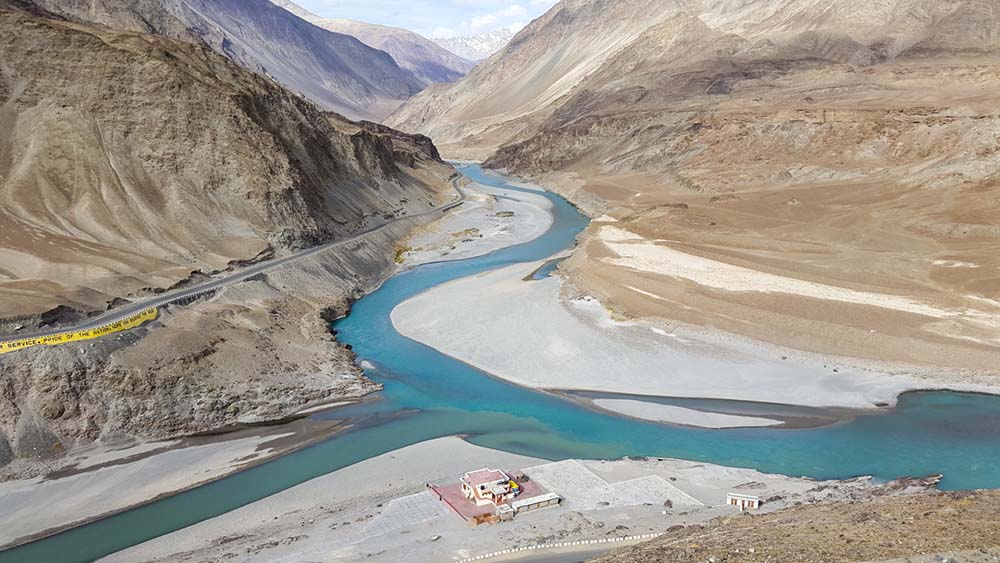
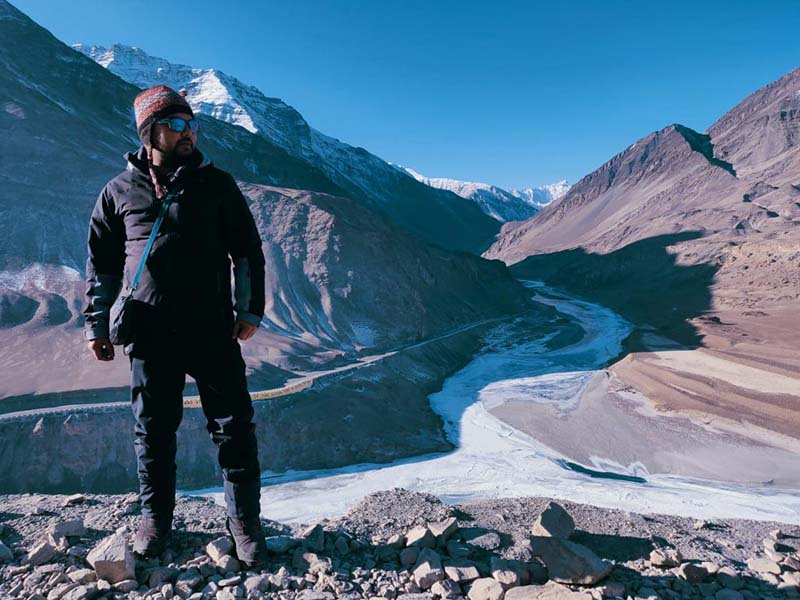
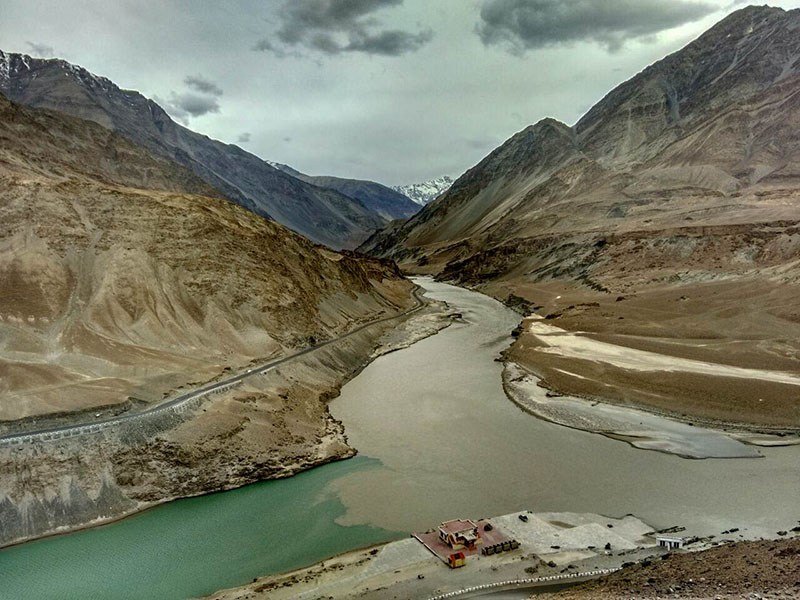




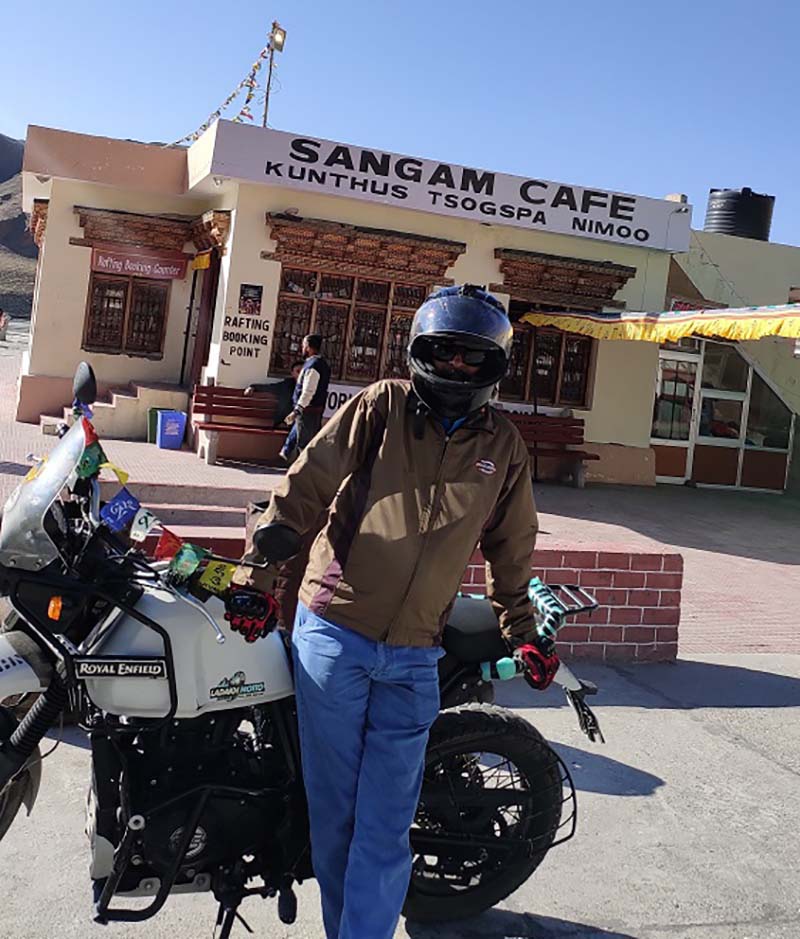
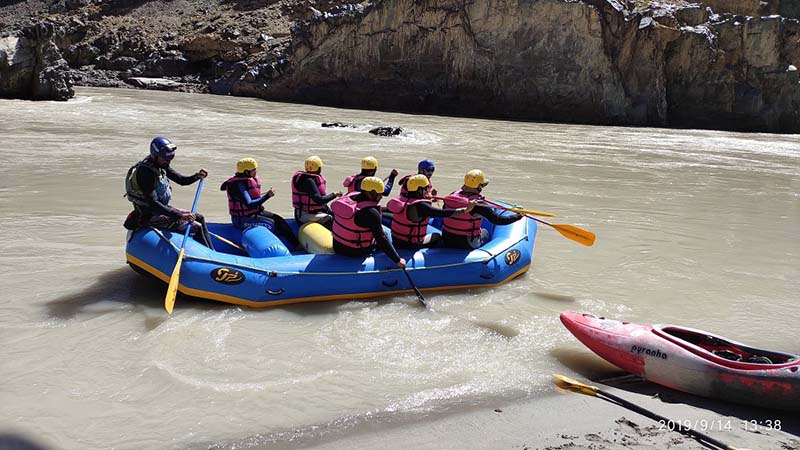

3 comments
Hi ,
Very informative, what is the colour of the rivers around mid September
Thank you, Kamalika. The first picture in the post is how it will look in September
Awesome drive. We went from Leh for an overnight stay at Uletupko. On the way stopped at Pathar sahib Gurdwara, magnetic hill, army mess, sangam, Likir, Alchi. A palace also comes in the way but were not recommended a stop. We spent the whole evening on the banks of the Indus at Ule. The drive and beauty is breathtaking